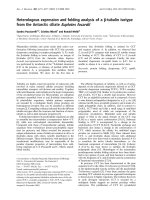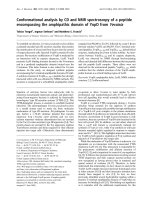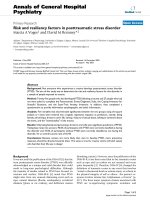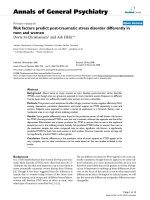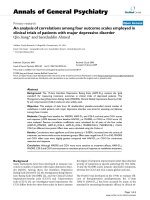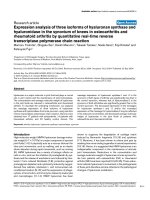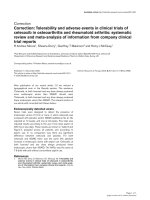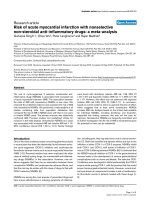Báo cáo y học: "Risk analysis and outcome of mediastinal wound and deep mediastinal wound infections with specific emphasis to omental transposition" pot
Bạn đang xem bản rút gọn của tài liệu. Xem và tải ngay bản đầy đủ của tài liệu tại đây (1.76 MB, 8 trang )
RESEARCH ARTICLE Open Access
Risk analysis and outcome of mediastinal wound
and deep mediastinal wound infections with
specific emphasis to omental transposition
Haralabos Parissis
1*
, Bassel Al-Alao
1
, Alan Soo
1
, David Orr
2
and Vincent Young
3
Abstract
Background: To report our experience, with Deep mediastinal wound infections (DMWI). Emphasis was given to
the management of deep infections with omental flaps
Methods: From February 2000 to October 2007, out of 3896 cardiac surgery patients (prospective data collection)
120 pts (3.02%) developed sternal wound infections. There were 104 males & 16 females; (73.7%) CABG, (13.5%)
Valves & (9.32%) CABG and Valve.
Results: Superficial sternal wound infection detected in 68 patients (1.75%) and fifty-two patients (1.34%)
developed DMWI. The incremental risk factors for development of DMWI were: Diabetes (OR = 3.62, CI = 1.2-10.98),
Pre Op Creatinine > 200 μmol/l (OR = 3.33, CI = 1.14-9.7) and Prolong ventilation (OR = 4.16, CI = 1.73-9.98).
Overall mortality for the DMWI was 9.3% and the specific mortality of the omental flap group was 8.3%. 19% of the
“DMWI group”, developed complications: hematoma 6%, partial flap loss 3.0%, wound dehiscence 5.3%. Mean
Hospital Stay: 59 ± 21.5 days.
Conclusion: Post cardiac surgery sternal wound complications remain challenging. The role of multidisciplinary
approach is fundamental, as is the importance of an aggressive early wound exploration especially for deep sternal
infections.
Introduction
The incidence of mediastinal wound infection in
patient s undergoing median sternotomy and open-heart
surgery can be up to 5%[1], [2]. A subgroup of 20-30%
of those patients [3] develops deep sternal infections
with an associated morbidity, mortality, and “ cost” that
remain unacceptably high [4]. There is a considerable
lack of consensus re garding the ideal operative treat-
ment of complicated (class 2b) El Oakley [5] sternal
wounds. The initial treatment with open packing and
ant ibiotic irrigation carries high mortality (up t o 50% at
Emory series) [6] and has become the treatment of the
past. Current treatment with radical sternal debridement
and closure using muscle or omental flaps has become
popular and is possibly asso ciated with lower mortality.
This paper reports our experience o n the management
of mediastinal wound infections with specific focus on
the use of omental flaps.
Methods
From February 2000 to October 2007, 3896 patients
underwent open heart surgery. Prospective data acquisi-
tion pertained to the patients was based upon the data-
set defined by the Society for Cardiothoracic Surgery in
Great Britain and Ireland.
Superficial sternal wound infection was defined as ster-
nal discharge confined to the skin and subcutaneous tis-
sues with no sternal instability. The presence of sepsis
associated with sternal instability, purulent discharge and
positive microbiology, defined deep mediastinal wound
infections. Non-infected, “ mechanical” dehiscence’s(El
Oakley class I) were excluded from this study.
Collection of the data is serve d using the Patients
Analysis and Tracking System (PATS) software. Eighty
variables were prosp ectively collected and carefully vali-
dated before being analyzed.
* Correspondence:
1
Cardiothoracic Dept, Royal Victoria Hospital, Grosvenor Rd, Belfast, BT12
6BA, UK
Full list of author information is available at the end of the article
Parissis et al. Journal of Cardiothoracic Surgery 2011, 6:111
/>© 2011 Parissis et al; licensee BioMed Central Ltd. This is an Open Access article distribu ted under the terms of the Creat ive Commons
Attribution License ( which permits unrestricted use, distribution, and reproduction in
any medium, provided the original work is properly cite d.
Categorical variables were tested using a qui square
test or Fisher exact test (two-tailed), and continuous
variables were tested using Students t test (two-tailed).
A p Value of less than 0.05 was regarded as statistical
significant. All calculations were made using SPSS 11
edition. Operative mortality is reported as 30-day mor-
tality, or as mortality occurred during the same hospital
admission (when the hospital stay was more than 30
days).
Bilateral pectora lis major myocutane ous advancement
flap with greater omental transposition: Surgical techni-
que (See Figures 1, 2, 3, 4, 5, 6, 7 and 8)
The omentum, a well vascularised tissue with its
immunologic and angiogenic properties, is a versatile
organ with well-documented utility in the reconstruc-
tion of complex wounds and defects. In our series it was
used as a pedicle. The median sternotomy incision is
only extended for 2 inches towards the umbilicus and
the peritoneal cavity is entered. The omentum is mobi-
lized and is brought up in to the ches t through a dia-
phragmatic opening; it fills the gap of the missing
sternum quite adequately. The pectoralis major muscle
based on the thoracoacromial artery is also mobilized.
This facilitates apposition of the pectoral musculature
and subcutaneous tissue “en mass” on top of the omen-
tum, in the middle line. We specifically avoid undermin-
ing the Pectoralis muscle off the subcutaneous tissues
and that preserves blood supply.
VAC pump
Vacuum-assisted closure system consisting of polyur-
ethane foam pieces and a special pump unit was used.
The foam was placed in the wound after debridement of
foreign material and necrotic tissue. The wound was
covered with adhesive drape and connected to the
pump unit, which was programmed to c reate a
continuous negative pressure of 125 mm Hg in the
wound cavity.
Results
Out of 3896 patients, 120 patients (3.02%) developed
sternal wound infections; There were 104 males and 16
females. 89 patients had undergone CABG (73.7%), 16
patients had Valve Surgery (13.5%), 11 patients had
CABG and Valves (9.17%) and 4 patients (3.3%) had var-
ious procedures. Overall, sternal wound infections were
diagnosed in 3.34% of the CABG patients, 3.79% of the
CABG and Valves and 3% of the Valve patients. Patie nt’s
demogra phics are pre sented in Table 1. The overall mor-
tality of the patients that they developed sternal wound
infections was 9.16% (11 patients). Concomitant leg
wound infection was found in 13 patients (10.84%).
Sixty-eight patients (1.75%) developed superficial sternal
Figure 1 Extensive bone debridement with a redo saw.
Figure 2 Sternal excision.
Figure 3 Raising of the pectoral flaps, by detaching the
pectoral muscle, off the chest wall.
Parissis et al. Journal of Cardiothoracic Surgery 2011, 6:111
/>Page 2 of 8
wound infection and treated with appropriate antibiotics,
local drainage and debridement of the wound. The mor-
tality of this group was 4.41% (3 patients).
The DMWI group
Fifty two patients (1.34%) developed DMWI. The overall
mortality of this group was 15.38% (8 patients).
The microbiology of the patients with DMWI
Blood cultures were positive in 30% of the patients with
DMWI. Wound microbiology revealed S. aureus (32%),
Coagulase Negat ive Staphylococcus (29.6%), methicilli n-
resistant Staphylococcus aureus (MRSA) (2.3%), Vanco-
mycin Resistant Enterococcus (VRE) (3.8%), Cram nega-
tive (17.5%) & other 14.8% (Anaerobics 1.2%, Fungal 4%).
The incremental risk factors (see Table 2) for develop-
ment of DMWI were: Diabete s (OR = 3.62, CI = 1.2-
10.98), pre-operative Creatinine > 200 μmol/l (OR = 3.33,
CI = 1.14-9.7) and prolong ventilation (OR = 4.16, CI =
1.73-9.98). Complications were developed in 9 patients
(17.3%): Seroma-hematoma 5 patients (9.62%), partial flap
loss 2 patients (3.85%), wound dehiscence 2 patients
(3.85%). Mean Hospital Stay: 59 ± 21.5 days. The likeli-
hood of developing complications in patients with DMWI
was higher: re-intubation rate 13.4%, new dialysis required
11.5%, Tracheostomy 9.6%, Prolong ventilation 34.6%. All
the patients with DMWI had their wounds checked at 6
months and 1 year following discharge. Healed wounds:
50 patients (96.2%), persistent pain and discomfort: 19
patients (37%), paresthesia-numbness 16 patients (30.7%)
and feeling of “sternal instability” 20 patients (38.5%).
Figure 4 Opening of the abdomen for the h arvesting of an
omental flap.
Figure 5 Harvesting of the in situ omental flap.
Figure 6 Coverage of the anterior mediastinum with omentum,
by transferring the omental graft via an anterior opening of
the diaphragm.
Figure 7 The omental flap is covered the anterior
mediastinum. The pectoral muscle is approximated in the middle
line using nylon loops. We avoid undermining the Pectoralis muscle
off the subcutaneous tissues and that preserves blood supply in the
area.
Parissis et al. Journal of Cardiothoracic Surgery 2011, 6:111
/>Page 3 of 8
VAC pump Group
18 patients (0.47%) were treated with vacuum assisted
closure VAC pump and secondary wound closure, due
to a partial sternal instability. There were initial treat-
ment failures in 2 patients requiring surgical revision.
The mortality for this group was 11.11% (2 patients).
Sternal debridement & primary re-suturing
16 patients (0.41%) were treated with early sternal
wound revision. In this group of patients during the
early post operative period the sternum became unstable
and purulent discharge was detected. The wound was
reopened, and the sternum was debrided; primary rewir-
ing was deemed suitable because the sternal bone was at
least partially intact. A betadine or Vancomycin irriga-
tion system was placed i n situ. The overlying musculo-
cutaneous tissue was closed over deep tension sutures.
Eventually the irrigation was removed when 3 negative
microbiology specimens were detected fro m the efflux
fluid. This group, consist off, males. Five (5) patients
had CABG, five (5) CABG & Valve and one (1) patient
has had Valve and other. There were initial tre atment
failures in 3 patients, which led to revisions. The mortal-
ity of this group was 18.75% (3 patients).
DMWI treated with Flaps
18 patients (0.47%) had variousflaps;12omental,3
combination o f rectal abdominal and pectoral flaps and
3 solely pectoral flaps. All the omental flaps were per-
formed following initial application of VAC pump up
till the purulent infection settled. There were 16 males.
The mean Euroscore of this gr oup was 5.8 (ranges,
Figure 8 The end result.
Table 1 Patient Characteristics
Patient
Demographics
Superficial N = 68 DMWIN = 52 Control N = 3896 pValue
Age 66.3 ± 9.9 67.1 ± 8.7 63.7 ± 10.7 NS
Gender (M) 86.7% 84.5% 78% NS
DM 19.2% 28.8% Diet: 4.5% Oral:8% Insulin:3.6% 0.023
Creatinine > 200
μmol/l
1.95% 5.05% 2.21% 0.027
Smoking History 67.8% 78.9% 69.7% NS
PVD 14.6% 16.8% 18.3% NS
COAD 13.2% 19.2% 17.9% NS
Leg wound infection 10.3% 11.5% 9.1% NS
BMI > 30 44.2% 46.1% 42.9% NS
EF Good: 63.7% Moderate: 31.4% Poor:
4.9%
Good: 65.4% Moderate 28.5% Poor:
6.1%
Good: 68.4% Moderate: 26.3% Poor:
5.3%
NS
Priority (Elective) 33.8% 32.7% 34.5% NS
Logistic Euroscore 4.2 ± 1.9 7.3 ± 3.6 3.71 ± 1.25 NS
Reoperation for
bleeding
4.4% 3.9% 4.5% NS
Prolong ventilation 5.8% 34.6% 6.8% <
0.001
Tracheostomy 1.5% 9.6% 1.8% <
0.001
New dialysis required 4.4% 11.5% 4.9% <
0.001
Re-intubation rate 4.4% 13.4% 4.7% <
0.001
Hospital stay(days) 19 ± 6 59 ± 21.5 9 ± 2.5 <
0.001
Parissis et al. Journal of Cardiothoracic Surgery 2011, 6:111
/>Page 4 of 8
between 1-13). Ten (10) patients had CABG, six (6) had
Valves and two (2) had CABG and Valve. The mean
Intensive Care Unit stay was 21.2 days (ranges, between
4 to 60 days). Two (2) patients developed post-operative
sepsis requirin g inotrop s and in two (2) patients Vanco-
mycin Resistant Enterococcus (VRE) was isolated. There
were initial treatment failures in 1 patient, who required
operative revision and eventually closure of the wound
with the aid of a VAC-pump. The mortality of this
group was 16.66% (3 patients).
Discussion
Radical debridement in order to eradicate infection is of
a paramount importance therefore sternal excision
becomes a necessity in cases with severe sternal involve-
ment. Under those circumstances various flaps have
been used; this study is not comparing the various treat-
ment strategies for DMWI because the number of the
patients involved is small, however outlines a trend of
action and also emphasizes the technique of omental
flap use.
The surgical approach for the treatment of DMWI
varies according to surgeon preference due to lack of
robust clinical evidence. A more favorable outcome has
been linked to different treatment strategies. Evolution
in treatments has led from tube irrigation of the medias-
tinumtotheuseofnegativepressurewoundtherapy
VAC pump [7] and lately to the introduction of muscle
flap coverage.
We agreeably accept that there is a role for all those
therapeutic modalities. During early diagnosis, of DMWI
withasalvageablesternumweadvocatereopeningof
the wound, debridement and rewiring. Tube irrigation
of the mediastinum using betadine or vancomycin infu-
sion is installed. The wound is close primarily with ten-
sion sutures; however, if the subcutaneous tissues are
under tension we use advanced pectoral flaps.
When the sternum is fractured in multiple places in a
high-risk patient (Severe COAD, use of BIMAs, alcoc-
holism, renal impairment, steroid therapy, and previous
radiation to the chest) or there is sternal ostomyelitis
then we excise the bone and fill the gap with omentum.
The wound is closed over advanced pectoral flaps (The
algorithm for the management of sternal w ound infec-
tions is presented in Figure 9). The latest strategy can
be performed in two ways: 1) For uncontrolled
Table 2 Multivariate logistic regression analysis of the
risk factors influencing DMWI
O.R. 95% C.I.
Risk factor p value
Diabetes Non 1.00
DMWI 3.62 1.20 10.98 0.023
Pre Op Creatinine > 200 μmol/l Non 1.00
DMWI 3.33 1.14 9.70 0.027
Prolong ventilation Non 1.00
DMWI 4.16 1.73 9.98 0.001
Wound discharge with fever ± WCC
Intact sternum
Sternal dehiscence
Drain the abscess,
Antibiotics, Remove
wires, VAC pump
Viable non infected
sternum, low risk patient
Necrotic infected
sternum, multiple
fractures, high ris
k
patients
Debride, Irrigate, Rewire,
primary or delayed wound
closure. If tissues under
tension
Debride, Use a
myocutaneous flap (one
or two stage procedure)
Use pectoral flap
Figure 9 Algorithm for the management of sternal wound infections.
Parissis et al. Journal of Cardiothoracic Surgery 2011, 6:111
/>Page 5 of 8
mediastinal sepsis, serial debridement and VAC pump
with delayed omental flap transposition and 2) single-
stage management, which consisted of debridement of
the sternal wound and omental flap transposition. The
need for laparotomy during omental harvesting and the
potential for intraabdominal complications have been
criticized; however donor-site complications are usually
limited to abdominal wall infection a nd hernia [8].
Moreover, debridement and flap coverage without oss-
eous closure makes subsequent re -interventions chal-
lenging. The loss of sternal integrity is a disadvantage,
not only because in up to 40% of the patient s it gives
local symptoms but particularly due to the fact that
makes r edo operations difficult. Therefore some groups
advocate thorough debridement and the use of the
vacuum-assisted closure system (VAC pump) for few
weeks following by the use of sternal clips [9] or sternal
osteosynthesis with horizontal titanium plates that can
be inserted in the parasternal space with consecutive
proper stabilization of the sternum [10]. Sternal preser-
vation whenever possible should be the aim, however if
delayed diagnosis or as per Immer et al [ 11] mediastini-
tis, in old sick patient s with poor vascularis ed multifrac-
tured sternum should be treated with sternal excision
and a musculo-cutaneous flap. Prolong antibiotic treat-
ment up to 6 weeks is usually advocated [12].
Some institutions are routinely managing deep sternal
infection with sternal wound debridement, rewiring, and
closed drainage, with or without antibiotic saline tube
irrigation (the traditional approac h). The mortality from
this traditional approach could be up to 37.5% [13] until
sternal debridement with muscle or omental flap recon-
struction became the standard treatment for this post-
operative complication and lowered the mortality rate to
just more than 5% [11,13]. The mortality in our series
of patients with DMWI treated with Sternal debride-
ment & re-suturing was 9% and with omental flaps was
8.3%. This is similar to the mortality reported by other
groups [14].
In our series of 52 DMWI patients, treated with 3 dif-
ferent modalities, the treatment failed in 6 patients
(11.5%). In 5 out of those 6 patients, MRSA or VRE had
been isolated. As per Douville et al, treatment failures
were dete cted in 18.8% of the patients following Sternal
debridement & re-suturing and in 24% of the muscle
flap patients [15]. Moreover partial flap loss occurred in
11.6% of the patients, with no total flap failures as per
Hul tman and colleagues [16]. Additional procedures for
recurrent sternal wound infection were necessary in
5.1% of patients [6]. The microbiology in our group of
patients correlates with other reports [14,15] and
includes mainly Gram positive in up to 61.6% of the
patient s, interestingly however in our report MRSA and
VRE was higher and up to 6.1%. It is worth mentioning,
that according to Yasuura et al [17 ] patients with blood
culture positive for methicillin-resistant Staphylococcus
aureus had recurrent sternal infections. Independent
predictors for DMWI in our study was diabetes, preo-
perative renal impairment and prolonged ventilation and
ICU stay such as alcocholics following re-intubation and
prolonged intensive care unit stay following delirium or
prolong vent ilation following a stroke. The use of
BIMAs in our institution was limited; therefore we were
unable to derive substant ial conclusions regarding
BIMAs.
A l arge report from Emory University [6] reported the
20 year institutional experience with 409 musculocut a-
neous flaps. There were: Pectoralis major flaps: 440
patients, Rectus abdominal flaps: 202 patients, Omental
flaps: 16 patients. The Risk factors for developing
DMWI were COAD, IABP use and the use of IMA,
BIMAs. Wound complications occurred in 19%. Mortal-
ity was 8-10% and Risk factors for death were septice-
mia, preoperative MI, and the use of IABP.
One year follow up of our patients showed healed
wounds in 50 patients (96.2%), however alm ost a third
of the patients continue to have persisten t pain and dis-
comfort paresthesia and a feeling of “sternal instability”.
Lon g term resu lts following sternal reconstruction were
reported by Ringelman et al [18]; 99% of the wounds
were healed. The morbidity however was high with per-
sistent pain and discomfort in 50% of the cases, Par-
esthesia-numbness in 44%, Sternal instability in 42%,
Post-operative weakness in the Shoulder-abdomen in
32%of the cases, Inability to perform the same pre-
operative activities i n 36% and finally Contour abnorm-
alities of the chest and abdomen in 85% of the patients.
Furthermore, Braxton et a l [19] reported that Mediasti-
nitis is associated with a marked increase in mortality
during the first year post-CABG and a threefold increase
during a 4-year follow-up period.
Compare to the rest of the cardiac surgical population,
the subgroup of patients that developed DMWI had a
similar incidence of reoperation for bleeding. However,
much higher incidence of prolonged ventilation, re-intu-
bation rate, tracheostomy rate and “new dialysis
required” was encountered in those patients.
Our study supports th e concept of using bilateral pec-
toralis major myocutaneous advancement flap with
greater omental transposition in DMWI, when the ster-
num is not viable or if the patient is a high risk. This
approach was tested in a small number of patients and
was found superior according to Brandt et al [20], and
Eifert et al [21]. However until level I evidence are avail-
able, clear cut indications as to who would benefit from
which approach, are lacking in the literature.
The initial limitation of our study is derived by its
observational retrospective nature. Our database consists
Parissis et al. Journal of Cardiothoracic Surgery 2011, 6:111
/>Page 6 of 8
of prospectively colle cted data; however, it was not
design to prospectively compare different strategies for
the treatment of DMWI. Furthermore the number of
the patients examined is small and also our follow up is
limited to one year.
Conclusions
Post cardiac surgery sternal wound complications
remain challenging. Efforts should focus on prevention
such as better perioperative glycaemic control [22].
Unfortunately, in patients with an increased risk for
sterna l instability and wound infection after cardiac sur-
gery, sternal reinforcement according to the technique
described by Robicsek did not reduce this complication
[23]. DMWI is associated with an increase rate of Mor-
bidity &Mortality, as well as high co sts [24]. Aggressive
ear ly wound exploratio n especially for DMWI and mul-
tidisciplinary approach involving plastic surgeons early
in the course, is of a paramount importance.
Possibly, flap repair is superior to more conservative sur-
gical options such as sternal resuturing with mediastinal
irrigation. Further reductions in mortality will depend on
earlier detection of mediastinitis, before the onset of septi-
cemia,andongoingmultisystemorganfailure.
Author details
1
Cardiothoracic Dept, Royal Victoria Hospital, Grosvenor Rd, Belfast, BT12
6BA, UK.
2
Plastic Surgery Dept, St James Hospital, St James Street, Dublin,
Dublin 8, Republic of Ireland.
3
Cardiothoracic Dept, St James Hospital, St
James Street, Dublin, Dublin 8, Republic of Ireland.
Authors’ contributions
HP gathered the data, participated in the sequence alignment and drafted
the manuscript, BA assist in data analysis, statistics and also the
development of the manuscript, AS helped with the collection of the data
and the construction of the manuscript, DO (Plastic Surgeon) participated in
its design and coordination and performed the omental harvesting and
surgery in the group of patients needed omental flaps and VY overlooked
the progress of the manuscript and advised on valuable amendments. The
authors read and approved the final manuscript.
Competing interests
The authors declare that they have no competing interests.
Received: 12 April 2011 Accepted: 19 September 2011
Published: 19 September 2011
References
1. Riddlerstolpe L, Gill H, Granfeldt H, Rutberg H: Superficial and deep sternal
wound complications: incidence, risk factors and mortality. Eur J
Cardiothorac Surg 2001, 20:1168-75.
2. Olsen MA, Lock-Buckley P, Hopkins D, Polish LB, Sundt TM, Fraser VJ: The
risk factors for deep and superficial chest surgical-site infections after
coronary artery bypass graft surgery are different. J Thorac Cardiovasc
Surg 2002, 124(1):136-45.
3. The Parisian Mediastinitis Study Group: Risk factors for deep sternal
wound infection after sternotomy: a prospective, multicenter study. J
Thorac Cardiovasc Surg 1996, 111:1200-7.
4. Loop FDLytle BW, Cosgrove DM, Mahfood S, McHenry MC, Goormastic M,
Stewart RW, Golding LA, Taylor PCJ: Maxwell Chamberlain memorial
paper: sternal wound complications after isolated coronary artery
bypass grafting: early and late mortality, morbidity and cost of care. Ann
Thorac Surg 1990, 49:179-87.
5. El Oakley RM, Wright JE: Postoperative mediastinitis: classification and
management. Ann Thorac Surg 1996, 61:1030-6.
6. Jones G, Jurkiewicz MJ, Bostwick J, Wood R, Bried JT, Culbertson J,
Howell R, Eaves F, Carlson G, Nahai F: Management of the infected
median sternotomy wound with muscle flaps. The Emory 20-year
experience. Ann Surg 1997, 225(6):766-76, discussion 776-8.
7. Petzina R, Hoffmann J, Navasardyan A, Malmsjö M, Stamm C, Unbehaun A,
Hetzer R: Negative pressure wound therapy for post-sternotomy
mediastinitis reduces mortality rate and sternal re-infection rate
compared to conventional treatment. Eur J Cardiothorac Surg 2010,
38(1):110-3.
8. Hultman CS, Carlson GW, Losken A, Jones G, Culbertson J, Mackay G,
Bostwick J, Jurkiewicz MJ: Utility of the omentum in the reconstruction of
complex extraperitoneal wounds and defects: donor-site complications
in 135 patients from 1975 to 2000. Ann Surg 2002, 235(6):782-95.
9. Reiss N, Schuett U, Kemper M, Bairaktaris A, Koerfer R: New method for
sternal closure after vacuum-assisted therapy in deep sternal infections
after cardiac surgery. Ann Thorac Surg 2007, 83(6):2246-7.
10. Baillot R, Cloutier D, Montalin L, Côté L, Lellouche F, Houde C, Gaudreau G,
Voisine P: Impact of deep sternal wound infection management with
vacuum-assisted closure therapy followed by sternal osteosynthesis: a
15-year review of 23,499 sternotomies. Eur J Cardiothorac Surg 2010,
37(4):880-7.
11. Immer FF, Durrer M, Mühlemann KS, Erni D, Gahl B, Carrel TP: Deep sternal
wound infection after cardiac surgery: modality of treatment and
outcome. Ann Thorac Surg 2005, 80(3):957-61.
12. Khanlari B, Elzi L, Estermann L, Weisser M, Brett W, Grapow M, Battegay M,
Widmer AF, Flückiger U: A rifampicin-containing antibiotic treatment
improves outcome of staphylococcal deep sternal wound infections. J
Antimicrob Chemother 2010, 65(8):1799-806.
13. Netscher DT, Eladoumikdachi F, McHugh PM, Thornby J, Soltero E: Sternal
wound debridement and muscle flap reconstruction: functional
implications. Ann
Plast Surg 2003, 51(2):115-22, discussion 123-5.
14. Sachithanandan A, Nanjaiah P, Nightingale P, Wilson IC, Graham TR,
Rooney SJ, Keogh BE, Pagano D: Deep sternal wound infection requiring
revision surgery: impact on mid-term survival following cardiac surgery.
Europ J of Cardiothorac Surgery 2008, , 33: 673-678.
15. Douville EC, Asaph JW, Dworkin RJ, Handy JR Jr, Canepa CS,
Grunkemeier GL, Wu Y: Sternal preservation: a better way to treat most
sternal wound complications after cardiac surgery. Ann Thorac Surg 2004,
78(5):1659-64.
16. Hultman CS, Culbertson JH, Jones GE, Losken A, Kumar AV, Carlson GW,
Bostwick J, Jurkiewicz MJ: Thoracic reconstruction with the omentum:
indications, complications, and results. Ann Plast Surg 2001, 46(3):242-9.
17. Yasuura K, Okamoto H, Morita S, Ogawa Y, Sawazaki M, Seki A,
Masumoto H, Matsuura A, Maseki T, Torii S: Results of omental flap
transposition for deep sternal wound infection after cardiovascular.
surgery Ann Surg 1998, 227(3):455-9.
18. Ringelman PR, Vander Kolk CA, Cameron D, Baumgartner WA, Manson PN:
Long-term results of flap reconstruction in median sternotomy wound
infections. Plast Reconstr Surg 1994, 93(6):1208-14, discussion 1215-6.
19. Braxton JH, Marrin CA, McGrath PD, Ross CS, Morton JR, Norotsky M,
Charlesworth DC, Lahey SJ, Clough RA, O’Connor GT, Northern New
England Cardiovascular Disease Study Group: Mediastinitis and long-term
survival after coronary artery bypass graft surgery. Ann Thorac Surg 2000,
70(6):2004-7.
20. Brandt C, Alvarez JM: First-line treatment of deep sternal infection by a
plastic surgical approach: superior results compared with conventional
cardiac surgical orthodoxy. Plast Reconstr Surg 2002, 109(7):2231-7.
21. Eifert S, Kronschnabl S, Kaczmarek I, Reichart B, Vicol C: Omental flap for
recurrent deep sternal wound infection and mediastinitis after cardiac
surgery. Thorac Cardiovasc Surg 2007, 55(6):371-4.
22. Matros E, Aranki SF, Bayer LR, McGurk S, Neuwalder J, Orgill DP: Reduction
in incidence of deep sternal wound infections: random or real? J Thorac
Cardiovasc Surg 2010, 139(3):680-5.
23. Schimmer C, Reents W, Berneder S, Eigel P, Sezer O, Scheld H, Sahraoui K,
Gansera B, Deppert O, Rubio A, Feyrer R, Sauer C, Elert O, Leyh R:
Prevention of sternal dehiscence and infection in high-risk patients: a
Parissis et al. Journal of Cardiothoracic Surgery 2011, 6:111
/>Page 7 of 8
prospective randomized multicenter trial. Ann Thorac Surg 2008,
86(6):1897-904.
24. Graf K, Ott E, Vonberg RP, Kuehn C, Haverich A, Chaberny IF: Economic
aspects of deep sternal wound infections. Eur J Cardiothorac Surg 2010,
37(4):893-6.
doi:10.1186/1749-8090-6-111
Cite this article as: Parissis et al.: Risk analysis and outcome of
mediastinal wound and deep mediastinal wound infections with
specific emphasis to omental transposition. Journal of Cardiothoracic
Surgery 2011 6:111.
Submit your next manuscript to BioMed Central
and take full advantage of:
• Convenient online submission
• Thorough peer review
• No space constraints or color figure charges
• Immediate publication on acceptance
• Inclusion in PubMed, CAS, Scopus and Google Scholar
• Research which is freely available for redistribution
Submit your manuscript at
www.biomedcentral.com/submit
Parissis et al. Journal of Cardiothoracic Surgery 2011, 6:111
/>Page 8 of 8


